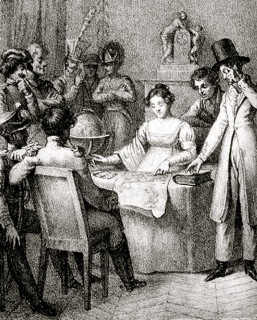Marie-Anne Lenormand
1772-1843When I was in Paris I went on a tour of Revolutionary Paris, through the Latin Quarter and around St. Germain. One of the sights we stopped to see was the flat where Madame Lenormand had plied her trade as a fortune teller. The guide found her story worth telling. She had read cards for Napoleon, he said. She had predicted the fall of Robespiere and almost ended up in prison for her cheek. After the tour, I began to read about her and I learned that among other things, she wrote a number of books, only one of which has been translated into English. She wrote it about Josephine, claiming she had special access to journals and papers the empress kept.
She never married and it's not easy to find personal details about her life. There are a number of very interesting reports from individuals who went to see her including Alexander Dumas and Lady Shelley. Lady Shelley was distantly related to Percy Bysshe Shelley. Chopin also visited Madame Lenormand. She, like many of the characters I'm writing about, is buried in Père Lechaise.
Madame Lenormand narrates The Appassionata in the tradition of Henry Fielding's, Tom Jones. I say that not to compare the books, but to explain the narrative style. She moves into the story and makes her presence felt in the first person and then disappears into the background as the story unfolds, returning at a later time to give insight and make comments, an "intrusive narrarator," the critics call it, a style of 18th and 19th century fiction.

